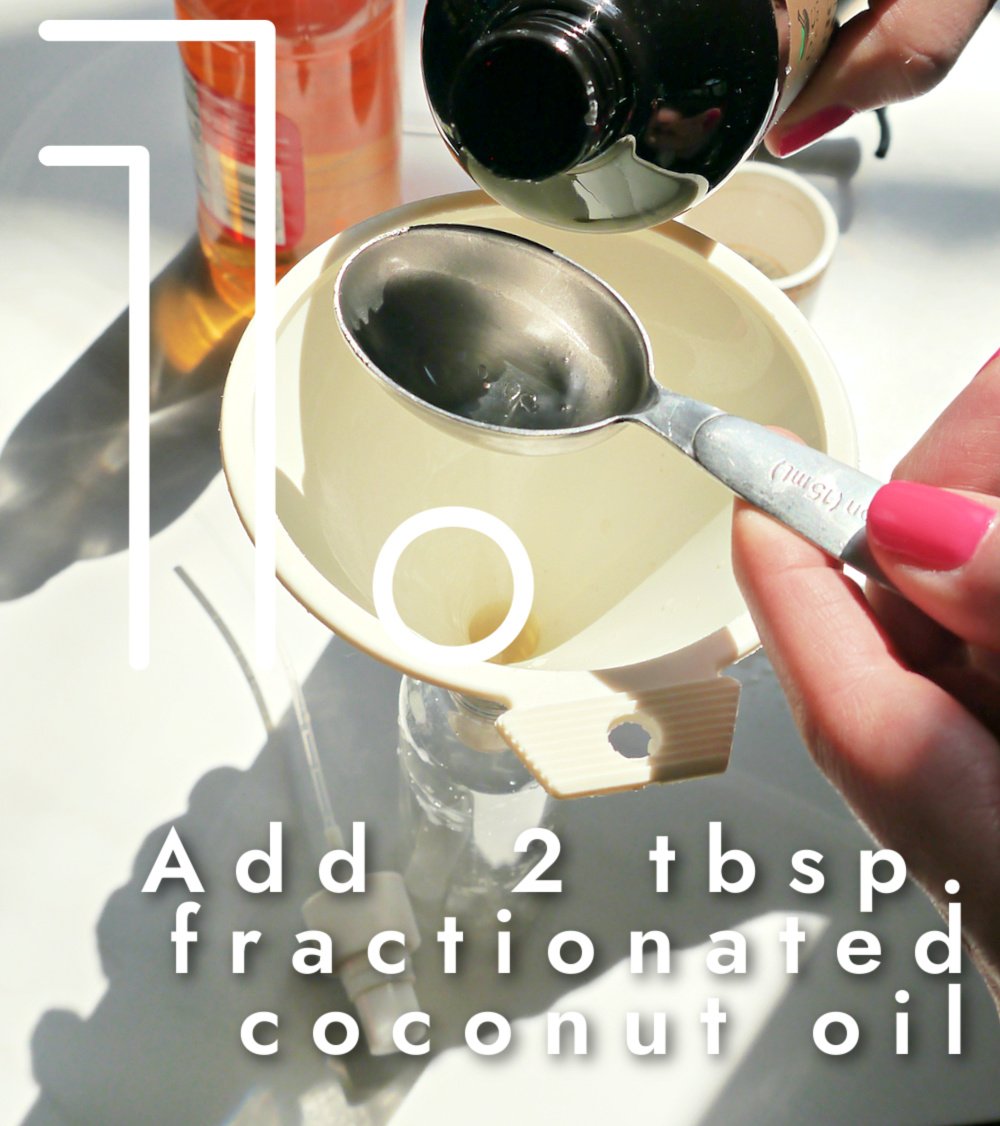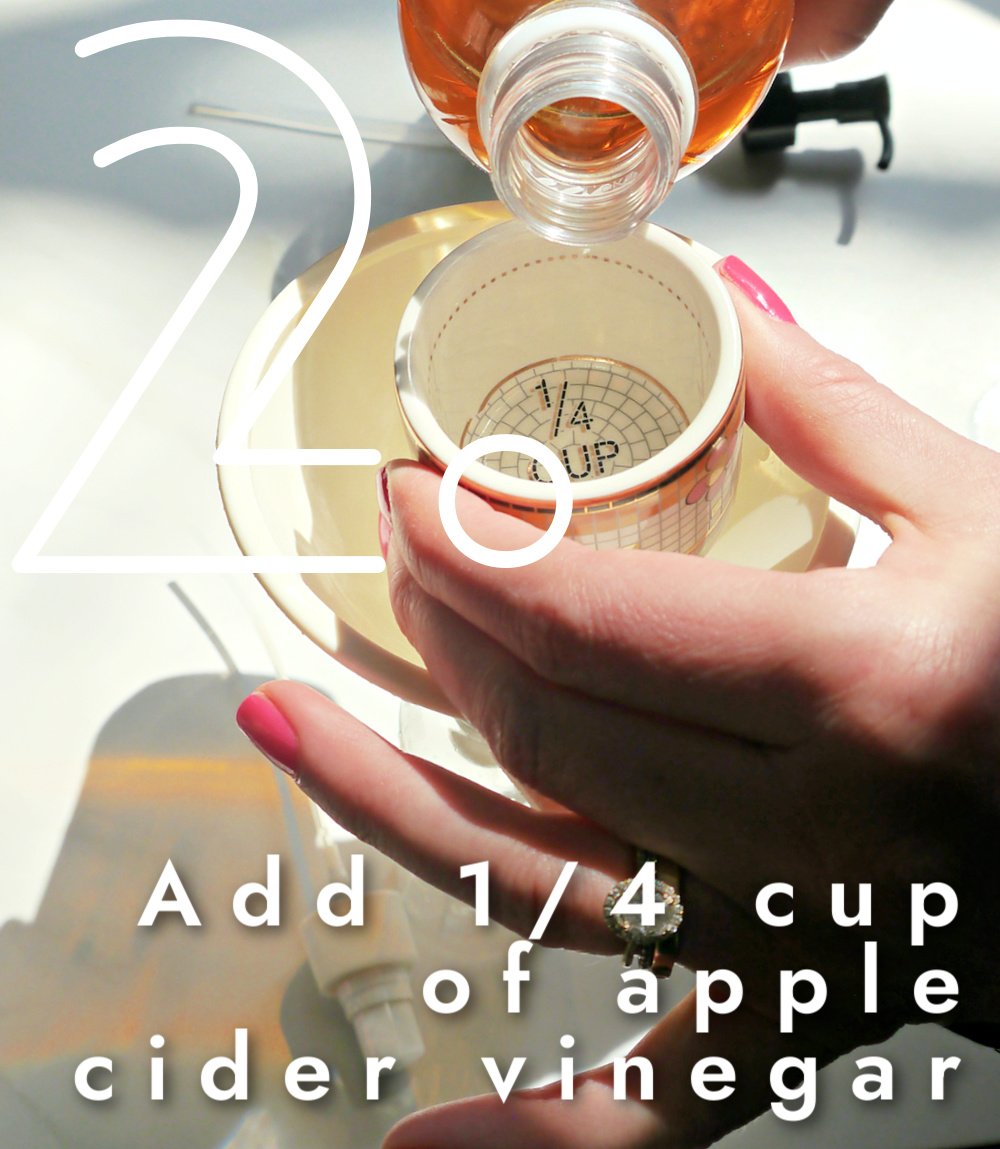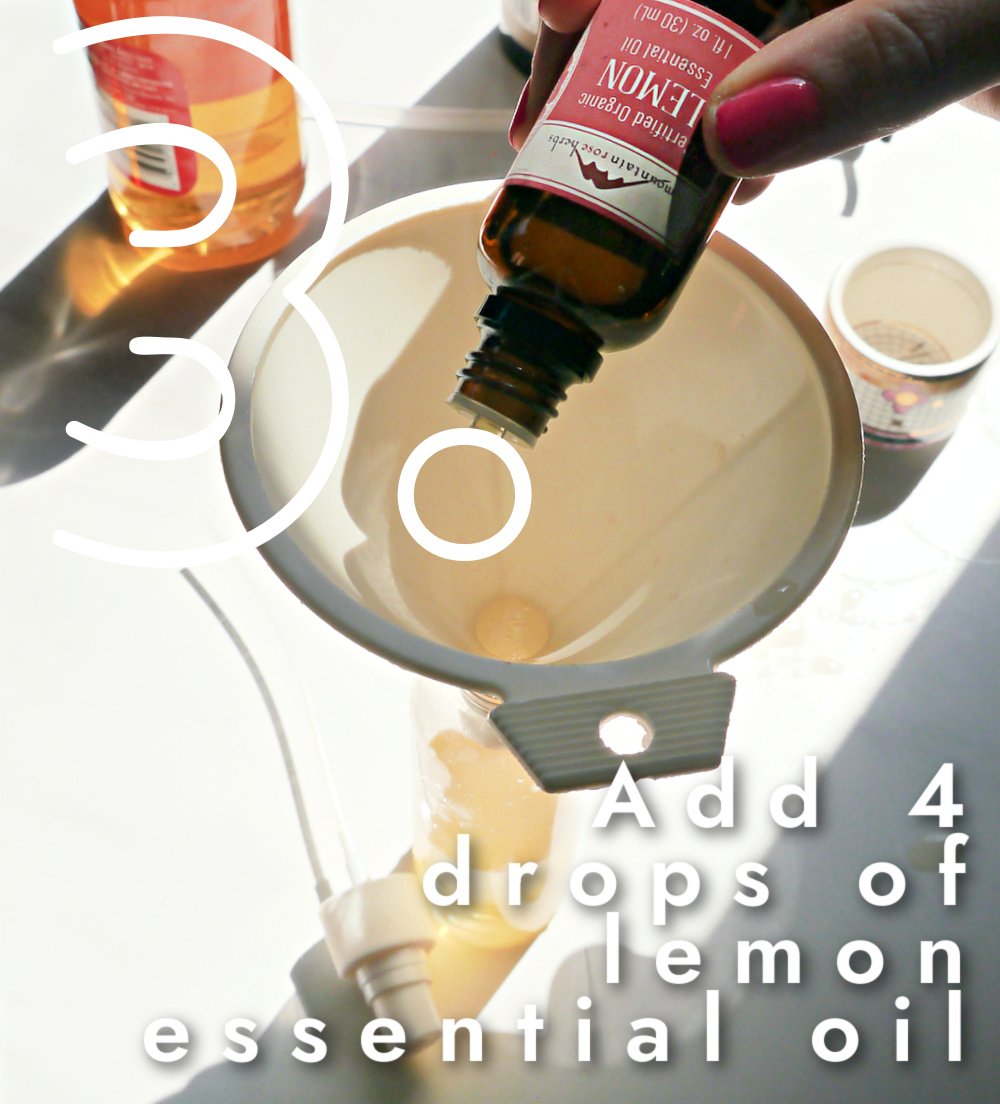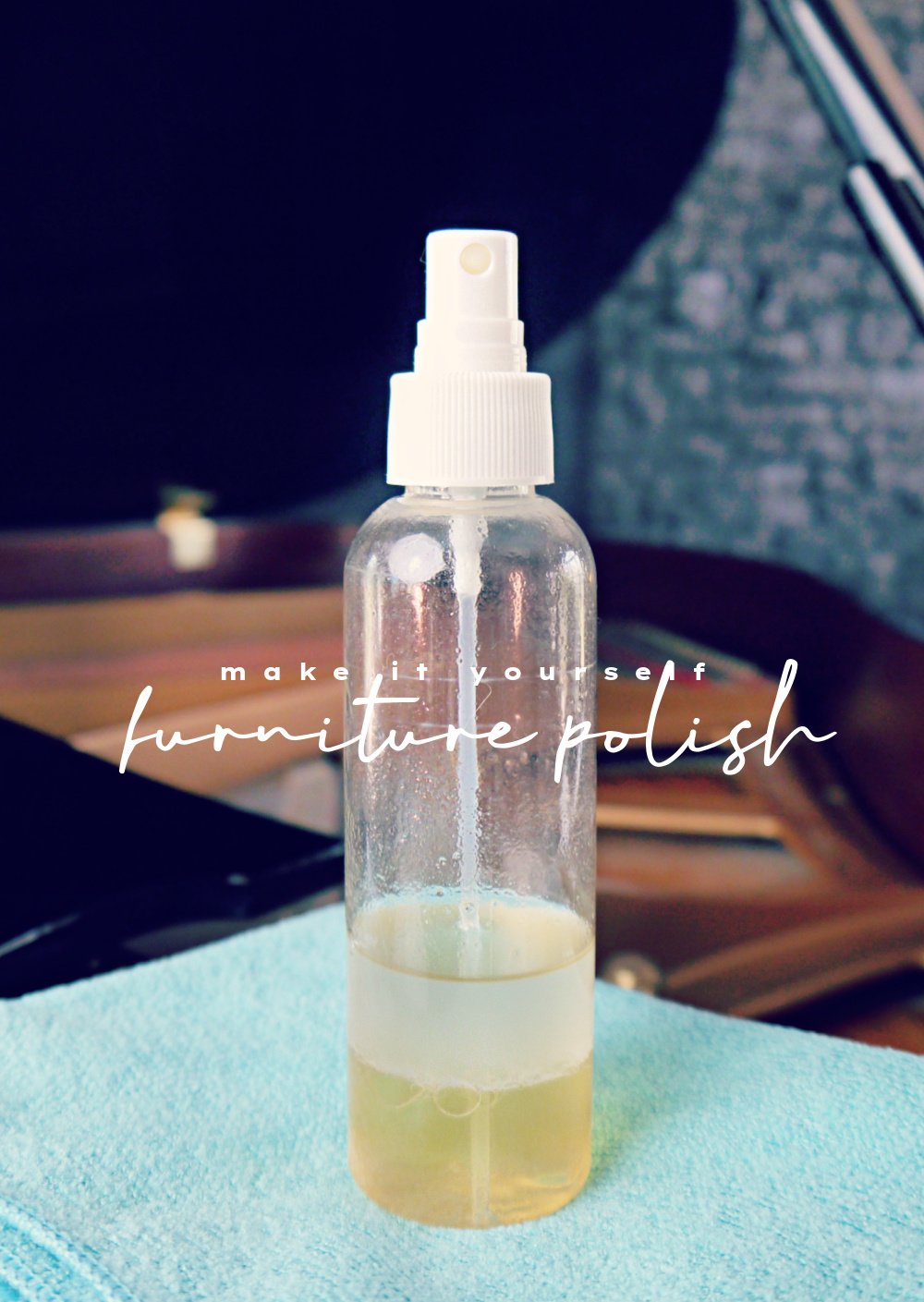Save money and toxic chemicals and make your own homemade furniture polish! With only 3 natural ingredients, this diy furniture polish is quick, cheap and effective. This is definitely one of those DIYs you wish you had made sooner!
I’m not the savviest of cleaners. I need things to be in their right places at all times but when it comes to dusting, I’m really quite lazy. I actually haven’t owned furniture polish in quite some time and have been using the Swiffer dusters but with spring in the air, I felt it time to actually clean the wood surfaces in my home because I have quite a few, including my baby grand piano that shows every finger print and speck of dust.
I figured it was worth a try to find a combination of ingredients that would not only clean but polish. As I mentioned, I am mainly concerned about my shiny, black piano. I needed to carefully and thoroughly clean it without harming the finish. By using a specific combination of fractionated coconut oil, apple cider vinegar and lemon oil, I landed on the perfect natural wood polish that does not leave a greasy residue, cleans the wood surface gently and does not harm the piece of furniture.
Why Not Use Commercial Furniture Polish Sprays?
Harmful chemicals are plenty in typical commercial furniture polishes. Not to mention synthetic fragrances and aerosol fumes. Commercial products also contain silicone. Silicone bonds with itself which means that every application causes build up. Over time the build up will make your wood look dingy and dirty even right after you polish it.
Making your own natural wood furniture polish with simple ingredients is safe for children and pets. However, if you have animals (or kiddos) that like to lick or chew on furniture, nix the essential oils. Plus, commercial polishes can be expensive!
Making a natural homemade polish is just too simple and effective to not DIY.
Related Post: How to Clean Carpet and Deodorize with Baking Soda
Homemade Furniture Polish Ingredients:
I chose fractionated coconut oil because it is a lighter oil. I absolutely did not want an oily finish on my furniture. I have too many cats and kids for that. However, many DIY recipes call for olive oil. I would’ve just started out with olive oil since I already had it, but I needed coconut oil for another DIY anyway. Plus, there is a question of this homemade recipe going rancid which is why we are making smaller batches at a time. Coconut oil has a shelf life of 1-2 years and is more stable than most oils. If you don’t have coconut oil, I would try olive oil for your first batch. Oil is what conditions the wood and gives the furniture a shine. Jojoba oil is also a great oil you can use on wood.
White vinegar was also common in other recipes. I heard that on darker wooden furniture, apple cider vinegar was the better choice than distilled white vinegar. I never found out why but I had some on hand and decided to use it instead of white vinegar. Especially since my piano is black. Honestly, I don’t think the type of vinegar you use is that important. Vinegar is what cleans the surface and cuts through dirt and grime.
Lemon Essential Oil is mainly because it smells good. However, lemon is great at cleansing and increases shine. If you’d like to skip it, you certainly can. Some recipes called for fresh lemon juice but I feel that the shelf life would be cut way down with fresh.
Why Use a Homemade Furniture Polish:
Using an oil based furniture polish is actually a great way to preserve and restore wood’s surface. Applying an oil can help seal in moisture and lock out damage. Using a furniture polish can immediately restore the rich look of your wood.
The Best Cloth to Polish Wood:
My mother always dusted with an old t-shirt of my dads. T-shirts are a great option since they are typically very soft. I decided to use microfibre cloths because they are so effective on other surfaces. They are soft as well and I felt they would be gentle on any surface. Plus they are affordable and I have been meaning to try them out with The Oil Cleansing Method.
What Not to Clean with Homemade Wood Polish?
I don’t recommend using this DIY on hardwood floors. There is too much of a risk of slipping.
Also, It makes sense that using a homemade furniture polish that contains oil on unfinished wood may not be a great idea. I would proceed with extreme caution and start in an inconspicuous area or nix the oil and just use vinegar.
Related Post: Thieves All-Purpose Cleaning Spray Recipe
What You Need to Make Your Own Furniture Polish:
Materials
- 2 tbsp. Fractionated Coconut Oil
- 1/4 cup Apple Cider Vinegar
- 4 drops Lemon Essential Oil
Tools
- 2-8 ounce Spray Bottle
- Microfiber Cloth
- Small Funnel
Instructions
- Using a small funnel, add 2 tbsp. of fractionated coconut oil, 1/4 cup of apple cider vinegar and 4 drops of lemon essential oil.



Notes
- Different DIY recipes call for different proportions of oil and vinegar. If you have a piece of furniture that needs extra moisture then you can raise the amount of oil you add.
- You don’t have to use lemon essential oil. You can use any citrus oil you have on hand. Orange, grapefruit and tangerine are great options.
- Apple Cider Vinegar is best for darker wood grains while white vinegar is best for lighter wood.
- I used a 4 ounce spray bottle and as you can see from the picture, my recipe only makes about 1/4 of that. Use what you have but if you need to buy a spray bottle I would suggest a 2 ounce glass bottle.
- Be sure to shake each time you use the spray. The oil and vinegar will always seperate and if you don’t shake, your furniture will only get the ACV.
For this natural furniture polish recipe, we will be making small batches at a time. Many DIYers whip up a simple recipe each time they clean but I prefer to make a small amount to keep on hand so that it is ready to go when ever I get the rare urge to dust. I am questioning the risk of bacteria growth. Vinegar does not go bad and adding lemon oil can help with bacterial issues as well. And as mentioned above, coconut oil has less a risk of going rancid than other oils. If you know something I don’t, please weigh in in the comments.
DIY Wood Polish Alternatives:
For a more conditioning, simple polish you can use oil and vinegar in equal parts and one part lemon juice and rather than spray it on wood, you can dip the corner of your cloth into the liquid and apply in the opposite direction of the grain in a circular motion. Using a clean cloth, wipe excess oil away.
You can also make a balm for intense wood shine and conditioning! Similar to a homemade Neosporin balm. The good thing about a furniture balm is that you don’t have to worry about it going bad. You can keep it on hand for 6+ months.
Related Post: Homemade PooPourri Recipe
Be sure to shake thoroughly each time you use your wood polish! Otherwise, you will only be spraying apple cider vinegar!
Homemade cleaning products can be very hit or miss. I’ve tried many and not shared them. However, this diy wood polish recipe is not one of those. I’ve had my piano since I was 13. I wish I would’ve discovered this DIY a long time ago because never have I been able to remove dust and fingerprints with such ease. There is no oiliness left behind, only a beautiful shine. I have a 15 year old solid wood dining table that needs refinishing desperately but with this wood polish spray my very beat up table looks about 50{2ac9033caf61aa83cf45584f992fcbdbe657ee6f770037f39c3ded45073822b8} better! This is a DIY you must make immediately!
Make this natural homemade furniture polish recipe. You won’t regret it and your furniture will thank you!
xx, Jenni
PIN IT!!!




